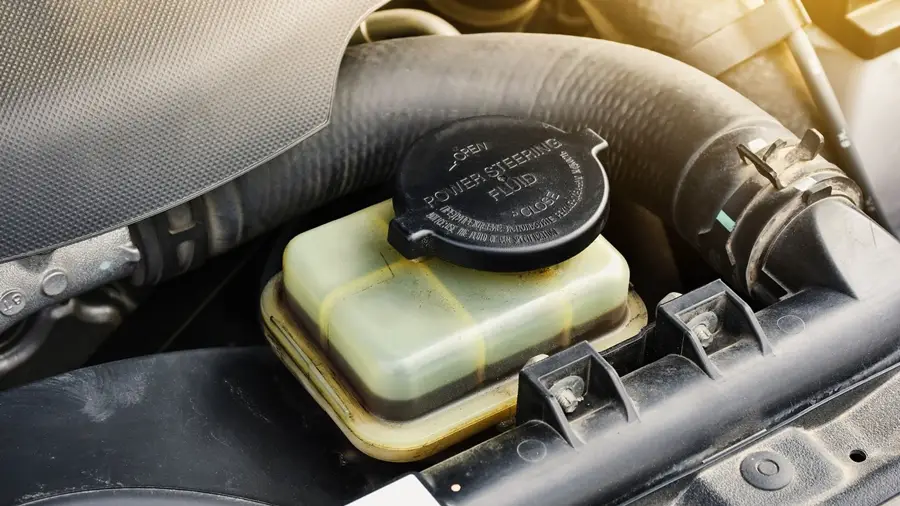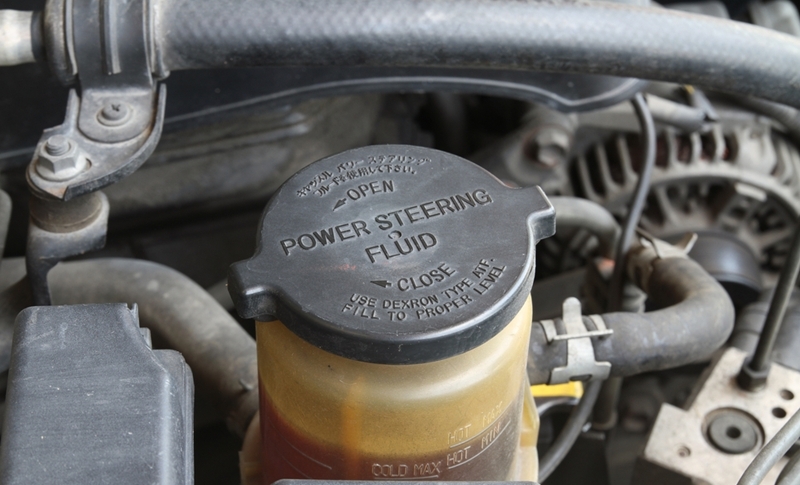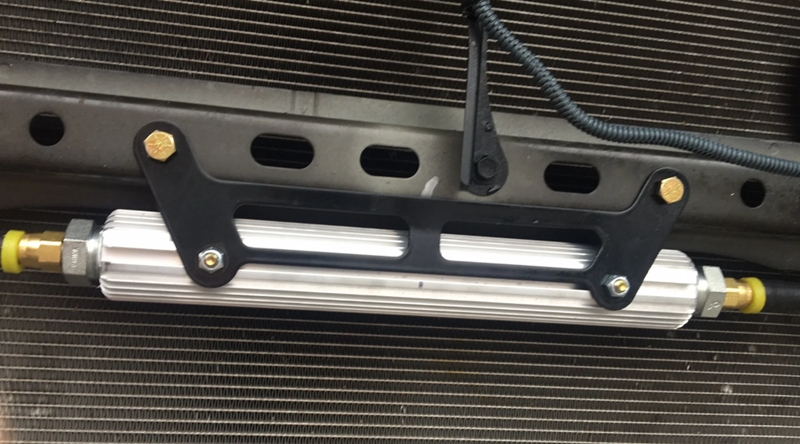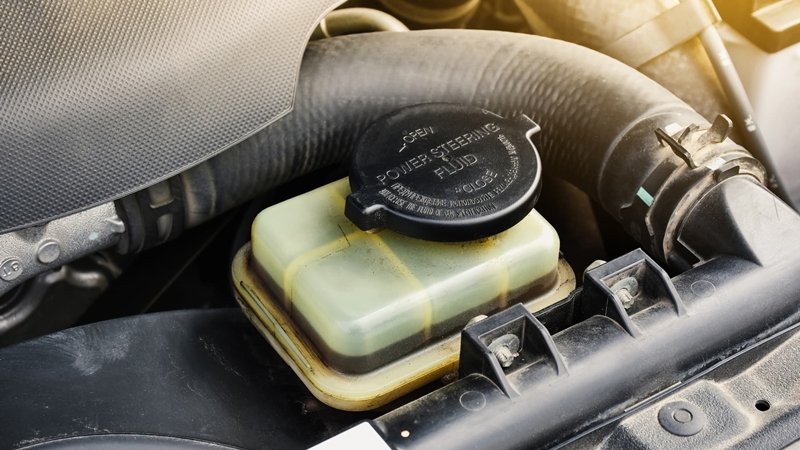Power steering liquid plays a crucial role in your vehicle’s steering system. Smooth steering is vital for safe driving, whether you’re navigating tight turns in the city or cruising on the highway. But with different types of power steering fluid available, how do you identify the best one for your car? This guide will break down the types of power steering fluid, key considerations for your decision, and average costs to expect.
Key Takeaways
- Power steering fluid is essential for smooth and responsive steering in vehicles with hydraulic or electro-hydraulic systems.
- There are multiple types of power steering fluid, including mineral-based, synthetic, ATF, and manufacturer-specific formulations—always check your owner’s manual before choosing.
- Using the wrong fluid can lead to steering system damage, leaks, or poor performance.
- Symptoms of low or bad fluid include stiff steering, whining noises, fluid discoloration, and leaks.
- Power steering fluid alternatives like ATF, mineral oil, or even vegetable oil can work temporarily in emergencies—but only with caution and compatibility checks.
- Most vehicles need 1–3 quarts of fluid, but exact requirements depend on the make, model, and condition of the steering system.
- Routine maintenance like checking fluid levels and replacing degraded fluid extends the life of your steering system and avoids costly repairs.
- Top brands include Prestone, Lucas Oil, Valvoline, and Royal Purple—offering reliable options for various budgets and needs.
Table of Contents
Signs of Power Steering Liquid Issues
It’s crucial to be vigilant about the condition of your p/s liquid, as several signs can indicate problems with the liquid or the steering system itself:
- Difficulty Steering: If steering becomes stiff or unresponsive, it could signal low p/s fluid levels or a failing pump.
- Leaks: Puddles of liquid under your vehicle or a wet steering rack might point to a steering fluid leak, which needs immediate attention.
- Unusual Noises: Whining or groaning sounds when turning the wheel often mean air is trapped in the system due to low p/s liquid.
Check out our Wrench and Ride Blog
What Is Power Steering Liquid?
Power steering liquid is a type of hydraulic fluid that helps your vehicle’s steering system work smoothly. It reduces the effort needed to turn the wheel and improves overall control. Using the right steering liquid ensures your system operates efficiently and lasts longer.
Most cars have a dashboard warning light specifically for p/s liquid. If it turns on, it usually means the fluid level is low. Ignoring it can increase steering effort and damage steering components.
7 Must-Know Facts About Power Steering Fluid
Before you top off your power steering system, here are seven essential facts that could save you from steering trouble—and costly repairs.
1. Not All Power Steering Fluids Are the Same
There are several types:
- Mineral Oil-Based – Common in older vehicles
- Synthetic Fluids – Better for extreme temps and modern systems
- Automatic Transmission Fluid (ATF) – Acceptable in some vehicles
- OEM-Specific Fluids – Made for specific car brands
Tip: Always check your owner’s manual for the correct type.
2. The Wrong Fluid Can Damage Your Steering System
Using incompatible fluid may lead to:
- Seal degradation
- Reduced performance
- Potential system failure
It’s better to delay a top-off than to use the wrong product.
3. Low or Contaminated Fluid Has Warning Signs
Watch out for:
- Difficulty steering
- Whining or groaning noises
- Jerky or stiff movement
- Leaking under the car
These signs often mean your fluid is low or degraded.
4. Power Steering Fluid Needs Maintenance Too
Even if levels look fine, fluid can break down over time.
- Check regularly for color and smell
- Change it if it’s dark, gritty, or burnt-smelling
Most systems need a flush every 50,000–100,000 miles.
5. Emergency Alternatives Exist—but Use with Caution
If you’re in a pinch, you can temporarily use:
- ATF
- Mineral oil
- Vegetable oil (only short-term)
These are not long-term solutions. Use only if OEM fluid is unavailable.
6. High-Quality Fluid Can Save You Money
While synthetic fluids cost more upfront, they:
- Last longer
- Protect seals
- Perform better in temperature extremes
This can reduce wear and tear, saving on repairs.
7. You May Not Even Need Fluid
Some modern cars use electric power steering (EPS), which doesn’t require fluid at all.
Always verify whether your vehicle has hydraulic, electric, or hybrid steering before purchasing fluid.
How to Check Power Steering Liquid Levels
To keep your power steering system in top shape, check your hydraulic steering liquid regularly. Most vehicles have a reservoir clearly marked for this purpose. Follow these steps:
- Locate the Reservoir: The power steering fluid reservoir is typically near the engine bay’s front, often on the driver’s side.
- Check the Level: With the engine off, remove the cap and look at the markings. The liquid should sit between the “min” and “max” lines.
- Top Off If Needed: If it’s low, add the manufacturer-recommended hydraulic steering liquid. Avoid overfilling, which can cause foaming and steering issues.
Where Is the Power Steering Liquid Located?
The power steering fluid reservoir is an important part of the system, responsible for holding and supplying the fluid that powers your steering. Knowing where to locate it can save you time during maintenance.
Common Reservoir Locations:
- Near the Engine: Many cars position the power steering liquid reservoir close to the engine for easy access.
- On the Firewall: In some models, it’s mounted on the firewall between the engine and passenger cabin.
- Integrated Systems: In newer cars, the hydraulic steering liquid reservoir may be built into the pump or steering gear.
How to Identify the Reservoir:
Look for a labeled cap—often marked with a steering wheel icon or the words “Power Steering Liquid.” The cap might be color-coded, typically yellow or black, to stand out from other reservoirs.

Color of Power Steering Fluid: What It Tells You
The color of power steering fluid can reveal a lot about its condition:
- Fresh Liquid: New p/s liquid is usually bright red or pink, thanks to its performance-enhancing additives.
- Aging Liquid: Over time, it may turn brown or black due to heat and contaminants.
If your hydraulic liquid is dark, cloudy, or smells burnt, it’s likely time for a flush. Old liquid doesn’t lubricate well and could damage components.
Why Regular Checks Are Important
Monitoring the color and level of your hydraulic steering liquid is a key part of vehicle maintenance. Ignoring signs like color change or odd smells can lead to pump failure, steering rack damage, and expensive repairs.
Power Steering Fluid Flush: When and Why
When your power steering fluid breaks down, replacing it is essential. A full system flush involves:
- Draining the old liquid
- Flushing out contaminants
- Refilling with new, manufacturer-approved p/s liquid
Using the right formula is vital—different vehicles may require specific types, and using the wrong one can reduce system performance.
Power Steering Fluid Symbol: What It Means
Many vehicles feature a dashboard warning symbol for power steering system fluid—usually a steering wheel icon with a droplet. If this symbol lights up:
- It may indicate low p/s liquid levels.
- A leak or aging fluid could also be the cause.
- Promptly addressing the issue can prevent further damage.
What to Do When the Warning Light Appears
If your steering system liquid warning light turns on:
- Pull over and shut off the engine.
- Locate and check the steering system liquid reservoir.
- If needed, top it off with the right fluid as specified in your manual.
Ignoring the warning can lead to harder steering and increased wear on your vehicle’s steering pump.
Preventive Maintenance for Hydraulic Steering Liquid
To avoid trouble:
- Get professional help if steering feels heavy or inconsistent.
- Check Hydraulic steering liquid levels regularly.
- Inspect for leaks under the vehicle.
- Listen for whining sounds during turns.
Types of Power Steering Fluid
It’s also important to note that different vehicles may require different types of steering liquid. Always refer to the vehicle’s owner manual to ensure that you are using the correct type of fluid for your specific make and model. Using the wrong steering liquid can lead to poor performance or even damage the steering system.
Download Your Free Power Steering Fluid Buying Guide (PDF)
Want a quick reference to help you choose the right fluid for your car?
Download our FREE Power Steering Fluid Buying Guide and take the guesswork out of shopping for power steering fluid!
1. Mineral Oil-Based Fluids
These are the most frequently used steering system liquids. Derived from refined petroleum, they work well with many older vehicles. While they perform adequately, they might not last as long or resist heat as well as synthetic options.
2. Synthetic Fluids
Synthetic steering liquids offer superior performance and durability. They are specifically made to provide excellent lubrication and resist breakdown. If you drive a newer model, these fluids can handle extreme temperatures better than mineral-based fluids. For example, some synthetic steering liquids remain effective in temperatures as low as -40°F (-40°C) and as high as 300°F (149°C).
3. Automatic Transmission Fluid (ATF)
For some vehicles, ATF doubles as power steering liquid. It’s vital to choose the right formulation of ATF, as using an incorrect type can lead to steering failure or damage.
4. Specially Formulated Fluids
Certain car manufacturers recommend steering liquids designed exclusively for their vehicles. These fluids typically contain unique additives that enhance performance. Always consult your owner’s manual to determine the right product for your car.
How to Choose the Right Power Steering Liquid
Finding the right hydraulic steering liquid can be straightforward if you consider these key factors:
- Manufacturer Recommendations: Check your vehicle’s owner manual for guidelines on the appropriate hydraulic steering liquid, including viscosity and type.
- Vehicle Age: Older models may perform better with mineral oil-based fluids, while modern engines often require synthetic hydraulic steering liquids.
- Driving Conditions: If you frequently encounter extreme weather or harsh driving conditions, synthetic power steering liquid is generally more reliable.
- Additives: Look for p/s liquids with seal conditioners if your vehicle is older and prone to leaks. These additives can help prevent leaks and improve fluid longevity.
- Compatibility: Always ensure the hydraulic steering liquid you select is compatible with your steering system to prevent potential issues.
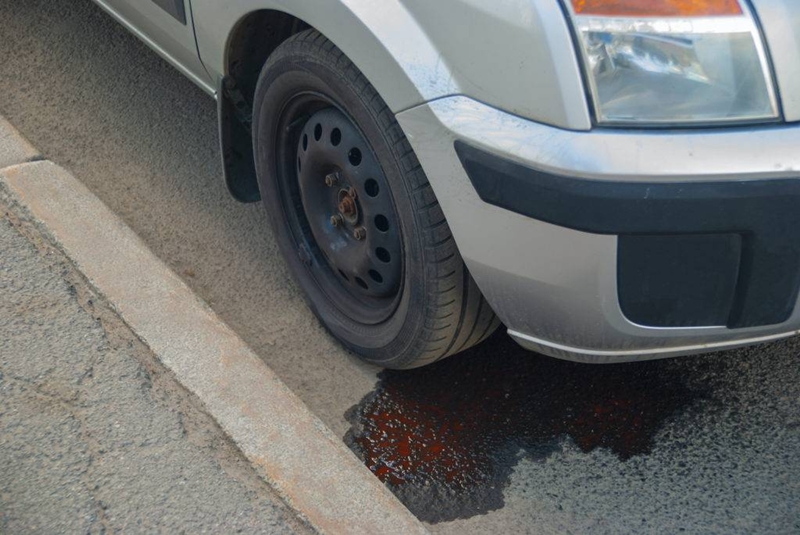
Symptoms of Low or Bad Power Steering Fluid
1. Difficulty Steering
If turning the wheel feels stiff or requires more effort than usual, especially at low speeds, your power steering fluid may be low or degraded.
2. Whining or Groaning Noise
A whining, squealing, or groaning noise when you turn the steering wheel often indicates the power steering pump is struggling—usually due to low or contaminated fluid.
3. Slow Steering Response
If your car doesn’t respond quickly or smoothly to your steering inputs, the fluid may be losing its hydraulic effectiveness due to age or contamination.
4. Power Steering Warning Light
Many newer vehicles have a power steering indicator light. If it turns on, it could mean low fluid levels or a system malfunction.
5. Fluid Leaks Under the Vehicle
Puddles or drips under the front of your vehicle might be power steering fluid, especially if the fluid is red, pink, or amber. Leaks will eventually lead to low fluid levels and damage.
6. Squealing on Startup
If you hear a squeal when starting the car, it might be a slipping belt caused by low fluid pressure affecting the power steering pump.
7. Burning Smell
Old or overheated power steering fluid can emit a burning odor. This often signals it’s breaking down and needs to be flushed and replaced.
Tip:
If you notice any of these symptoms, check the fluid level and condition immediately. Ignoring them can lead to pump failure, steering rack damage, or loss of steering control—which are all expensive to fix.
Would you like this formatted into a blog section or added to your existing post?
Popular Brands of Power Steering Liquid
- Prestone: This brand is known for its dependable hydraulic steering liquid formulations that perform well in various environments.
- Lucas Oil: Popular among car enthusiasts, their synthetic power steering liquid is trusted for extended performance and reliability.
- Valvoline: A well-respected name offering a range of steering liquids, including high-quality synthetic options.
- Royal Purple: This brand is recognized for its fully synthetic hydraulic steering liquids that provide optimal protection and performance.
Power Steering Liquid Price
When budgeting for your next bottle of p/s liquid, you may ask, how much is power steering liquid? Prices can vary based on type and brand:
- Mineral Oil-Based Fluids: Typically priced between $5 to $15 per quart.
- Synthetic Fluids: Generally cost between $15 to $25 per quart. Although they may have a higher upfront cost, they can lead to significant savings by reducing wear on your steering system.
- Specialty Formulations: Depending on the brand and specific requirements, these can range from $20 to $30 or more.
Investing in the right p/s fluid can lead to better performance and reduce costly repairs down the line.
Where to Buy Power Steering Liquid
You have several options when purchasing p/s fluid:
- Online Retailers: Websites like Amazon and Walmart offer a wide variety of steering liquids at competitive prices.
- Auto Parts Stores: Stores such as AutoZone or O’Reilly Auto Parts provide personal assistance and often have discounts and promotions.
- Dealerships: If your vehicle requires manufacturer-specific p/s liquid, your local dealership can accommodate, though typically at a higher price.
- Big Box Stores: Retailers like Target, Walmart, and Costco generally stock steering liquid at competitive rates, making them a convenient option.
Power Steering Liquid Alternatives
Steering liquid is a crucial component in the hydraulic systems of modern vehicles, allowing for smoother steering and enhanced control. However, there are instances where you might need a hydraulic steering liquid alternative—whether due to unavailability, cost concerns, or the desire for a more eco-friendly option.
Emergency Alternatives for Power Steering Liquid
Automatic Transmission Fluid (ATF)
Many manufacturers allow the use of ATF as a hydraulic steering liquid alternative due to its similar viscosity and lubricating properties. Always check your owner’s manual first.
Mineral Oil
Some mineral oils can serve as a temporary steering liquid replacement, though they lack the specialized additives found in dedicated formulations.
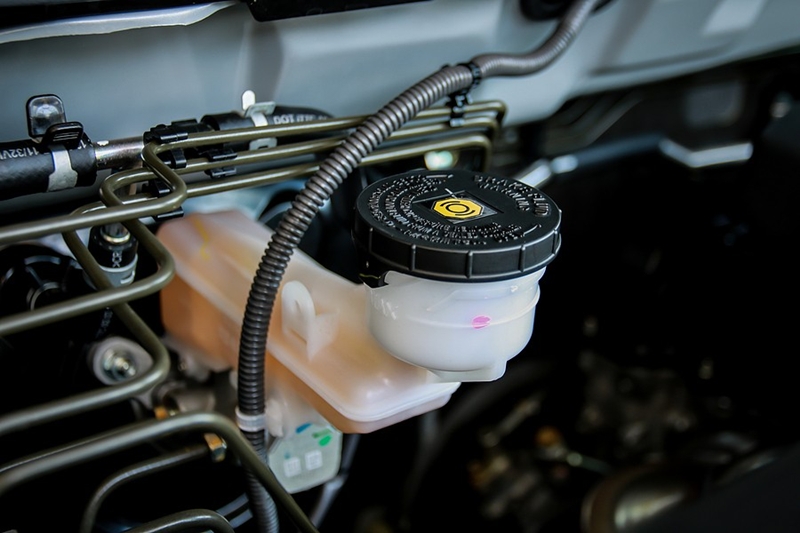
Considerations When Using Alternatives Instead of Power Steering Liquid
When considering a steering liquid alternative, it is crucial to keep several important factors in mind:
Compatibility
Always ensure the alternative hydraulic steering liquid is compatible with your vehicle’s steering system. Using an incompatible fluid may cause leaks, performance issues, or even permanent damage.
Performance
Many alternatives do not perform as well as genuine p/s liquids, especially under extreme temperatures or heavy driving conditions. It’s essential to monitor steering response and fluid quality regularly when using a substitute.
Environmental Impact
If you’re searching for a greener option, consider biodegradable p/s fluid made for eco-conscious vehicle owners. These products are formulated to reduce environmental impact while still maintaining reliable performance.
Cost-Effectiveness
While some hydraulic steering liquid alternatives may seem budget-friendly at first, they could lead to more frequent repairs or system wear over time. In the long run, choosing the proper fluid is typically more economical and safer.
Important:
While several alternatives to traditional power steering liquid exist, each comes with trade-offs. Always weigh the pros and cons, consult your vehicle manufacturer’s guidelines, and use alternatives only in emergencies—when the recommended hydraulic steering liquid isn’t available. The health of your power steering system plays a vital role in vehicle safety and comfort, so prioritize compatibility and quality above all else.
How Much Power Steering Liquid Does a Car Need?
Steering liquid is a vital part of your car’s steering system. It supplies the hydraulic pressure necessary for smooth and responsive handling. But how much fluid does your vehicle actually need?
Factors Influencing Power Steering Liquid Capacity
- Vehicle Make and Model
Different manufacturers use varying steering system designs, affecting how much p/s liquid is required. A compact sedan may use less than a full-size truck. Always consult your owner’s manual for the correct volume and type. - Type of Power Steering System
Hydraulic systems depend on p/s liquid, typically requiring between 1 to 3 quarts. In contrast, electric power steering systems don’t need fluid at all. Knowing your system type is the first step in proper maintenance. - Fluid Condition and Maintenance
Over time, hydraulic steering liquid can become contaminated or break down due to heat. Low fluid levels may indicate a leak, while dark or burnt-smelling liquid means it’s time for a flush and refill. Regular checks help avoid steering problems and costly repairs.
Frequently Asked Questions About Power Steering Fluid
-
Can I mix different types of power steering fluid?
It’s generally not recommended. Mixing fluids—especially synthetic and mineral-based types—can lead to chemical incompatibility, reduced effectiveness, and potential damage to your steering system. Always use the type specified in your owner’s manual.
-
How often should I change power steering fluid?
Most manufacturers recommend changing it every 50,000 to 100,000 miles, but this can vary. Check your manual or have it inspected during regular maintenance.
-
What happens if I use the wrong power steering fluid?
Using the wrong type can cause seal damage, poor steering performance, leaks, or complete system failure over time. Always confirm compatibility with your vehicle’s manufacturer.
-
Can I drive with low power steering fluid?
Technically yes—but it’s risky. Low fluid can lead to hard steering, increased wear on the pump, and eventual system failure. Top it off as soon as possible and check for leaks.
-
Is ATF (Automatic Transmission Fluid) okay to use in power steering systems?
Only if your vehicle’s manual says so. Some vehicles are designed for ATF, but many require dedicated power steering fluid. Always double-check before using ATF as a substitute.
-
How do I check my power steering fluid level?
Locate the reservoir under the hood—typically labeled—and check the level against the markings on the side or dipstick. Make sure the engine is off and the car is cool when doing so.
-
What color should power steering fluid be?
Clean power steering fluid is usually clear, amber, red, or pink, depending on the type. If it appears dark, brown, or has a burnt smell, it’s time for a change.
-
Is power steering fluid the same as hydraulic fluid?
Power steering fluid is a type of hydraulic fluid, but not all hydraulic fluids are safe for use in a power steering system. Use only what’s recommended for your vehicle.
Need a mechanic? Find one on the Mobile Mechanic Directory
Final Thought
Choosing the right power steering liquid depends on your vehicle’s specifications, driving environment, and maintenance habits. Always follow the manufacturer’s recommendations, and if you’re ever in a pinch, use alternatives with caution—and only temporarily.
Routine checks and timely replacements of your hydraulic steering liquid are key to keeping your steering system healthy. It’s a small task that ensures big benefits in handling, safety, and driving comfort. Happy driving!

